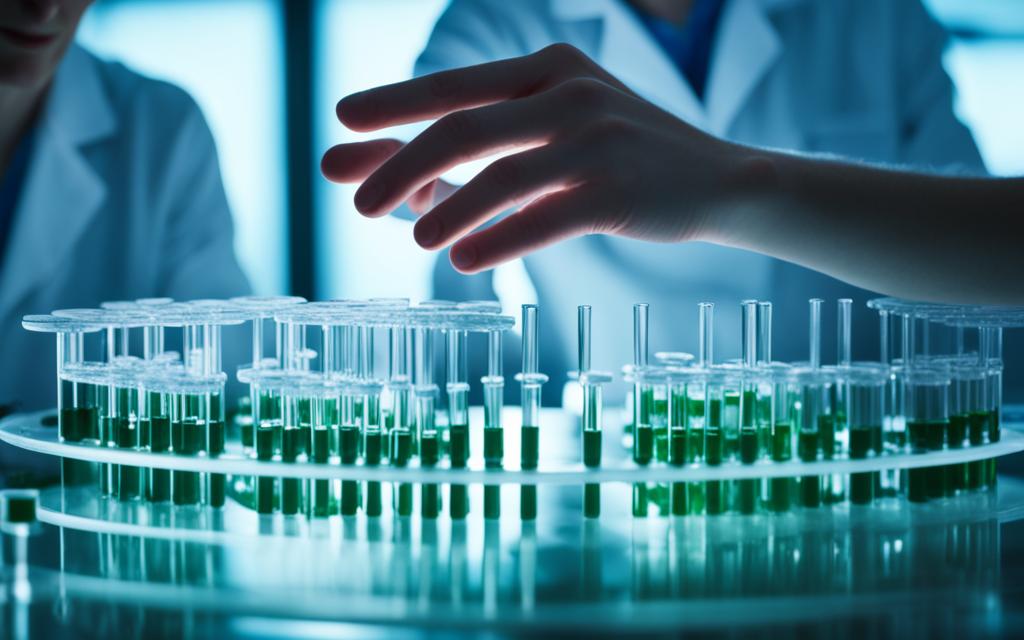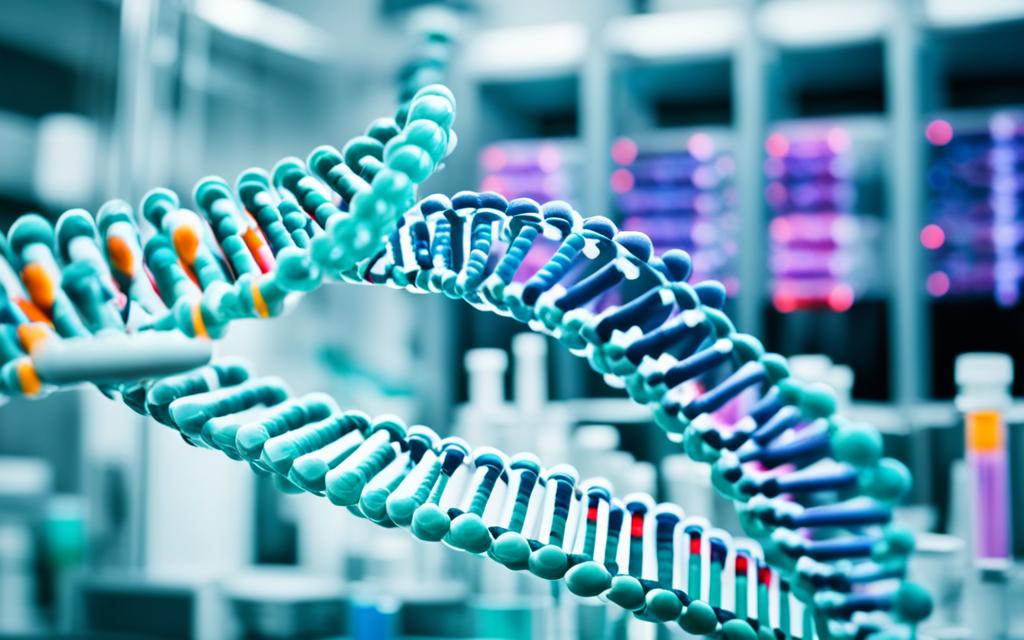Biotechnology and genetic engineering innovations are revolutionizing modern lifestyles, from personalized medicine to sustainable agriculture and beyond. These advancements have the potential to extend healthy lifespans, relieve suffering, and fundamentally change how we live and work. To harness the full potential of biotechnology, the United Kingdom must establish a leading position in this rapidly evolving field, building on its existing strengths in areas like genomics research and the response to the COVID-19 pandemic. By strategically investing in new institutions, leveraging health data, supporting biotech startups, and ensuring responsible governance, Britain can become a global hub for biotechnology and secure its future prosperity.
Key Takeaways
- Biotechnology and genetic engineering are transforming various aspects of modern life, from healthcare to agriculture.
- The United Kingdom has the opportunity to become a global leader in biotechnology by leveraging its existing strengths and strategic investments.
- Advancements in areas like recombinant DNA technology, gene cloning, and genome editing have the potential to extend healthy lifespans and improve quality of life.
- Responsible governance and ethical considerations are crucial as the United Kingdom harnesses the full potential of biotechnology.
- Biotechnology can contribute to the United Kingdom’s future prosperity by driving innovation, creating jobs, and addressing global challenges.
Introduction to Biotechnology and Genetic Engineering
Biotechnology is a broad field that encompasses the use of living organisms, such as cells and biological molecules, to develop products and technologies that improve human life. Genetic engineering, a core aspect of biotechnology, involves the direct manipulation of an organism’s genetic material to alter its characteristics or introduce new traits. The scope of biotechnology spans a wide range of applications, including medicine, agriculture, environmental remediation, and industrial processes. From the development of recombinant DNA technology to the emergence of gene editing tools like CRISPR, biotechnology has undergone remarkable advancements that are transforming various domains.
Historical Overview of Genetic Engineering
The field of genetic engineering has a rich history, with key milestones dating back to the 1970s. The development of recombinant DNA technology, which allows the manipulation of genetic material from different sources, paved the way for the creation of transgenic organisms and the advancement of gene cloning techniques. Over the decades, genetic engineering has evolved, with the emergence of powerful genome editing tools like CRISPR-Cas9 revolutionizing our ability to precisely modify DNA sequences. These technological breakthroughs have enabled groundbreaking applications in medicine, agriculture, and beyond, opening up new frontiers for biotechnology.
Applications in Various Domains
Biotechnology and genetic engineering have far-reaching applications across diverse domains. In medicine, these technologies have led to the development of personalized therapies, gene therapies, and biopharmaceuticals that target specific genetic conditions and diseases. In agriculture, genetic engineering has enabled the creation of crops with enhanced traits, such as improved pest resistance, drought tolerance, and nutritional value. Environmental applications include the use of genetically modified organisms for bioremediation and the production of biofuels. The field of synthetic biology, which combines biotechnology and engineering principles, has also emerged, allowing the design and construction of novel biological systems and devices. The convergence of biotechnology with advancements in areas like computational biology and artificial intelligence has further expanded the reach and potential of these technologies.
Biotechnology and Genetic Engineering
Biotechnology and genetic engineering are closely intertwined fields that have become increasingly integral to modern life. Advancements in these areas have the potential to revolutionize various aspects of society, from medicine and agriculture to industrial processes and environmental sustainability. The rapid progress in technologies like recombinant DNA, gene cloning, and genome editing has enabled unprecedented control over biological systems, opening up new frontiers for innovation and problem-solving.
As biotechnology continues to evolve, it is crucial for the United Kingdom to establish a leading position in this dynamic and rapidly advancing field, leveraging its existing strengths and strategic investments to capitalize on the immense opportunities it presents. From the development of biopharmaceuticals and gene therapies to the creation of transgenic organisms with enhanced traits, the impact of biotechnology and genetic engineering is being felt across diverse domains, including biomolecular engineering, synthetic biology, and bioinformatics.

By harnessing the power of these transformative technologies, the UK can position itself as a global hub for biotechnology and genetic engineering, driving advancements that address pressing challenges in healthcare, agriculture, and environmental sustainability. Through strategic investments, collaborations, and responsible governance, the nation can unlock the vast potential of biotechnology and secure its future prosperity.
Recombinant DNA Technology
Recombinant DNA technology is a fundamental aspect of biotechnology, enabling the direct manipulation of genetic material. This technology involves the insertion of DNA sequences from one organism into a different organism, creating a genetically modified or “recombinant” organism. The process typically involves the use of enzymes to cut and join DNA fragments, as well as vectors, such as plasmids or viruses, to deliver the foreign genetic material into the host organism. Recombinant DNA techniques have been instrumental in the development of a wide range of applications, from the production of therapeutic proteins to the creation of transgenic crops and animals with desired traits.
Principles and Techniques
The core principles of recombinant DNA technology revolve around the ability to isolate, modify, and reintroduce genetic material into a host organism. Researchers employ a variety of techniques, such as restriction enzyme digestion, DNA ligation, and vector-based delivery systems, to accomplish this feat. The precise manipulation of DNA sequences has unlocked new possibilities in the fields of biotechnology and genetic engineering.
Applications in Medicine and Agriculture
Recombinant DNA technology has had a profound impact on the fields of medicine and agriculture. In medicine, this technology has enabled the production of recombinant therapeutic proteins, such as insulin and various drugs, which have revolutionized the treatment of numerous diseases. Additionally, recombinant DNA techniques have facilitated the development of gene therapies, where genetic material is introduced into cells to treat genetic disorders. In agriculture, recombinant DNA technology has been used to create genetically modified crops with enhanced traits, such as improved pest resistance, drought tolerance, and nutritional value. These advancements have significantly improved food security and sustainability, while also opening up new avenues for industrial applications of biotechnology.
Gene Cloning and Transgenic Organisms
Gene cloning is a critical technique in biotechnology, allowing the isolation and replication of specific DNA sequences. This process typically involves the use of cloning vectors, such as plasmids or viruses, to carry the target DNA into a host organism, often a bacterial cell or yeast. The host organism then replicates the foreign DNA, producing multiple copies of the desired gene. The development of advanced cloning vectors and the optimization of host systems have been instrumental in the creation of transgenic organisms, where genetic material from one species is introduced into another, conferring new traits or capabilities.
Cloning Vectors and Hosts
Cloning vectors, such as plasmids and viruses, play a crucial role in gene cloning by facilitating the transfer of target DNA into a suitable host organism. These vectors act as carriers, transporting the genetic material into the host cells, where it can be replicated and expressed. The selection of appropriate vectors and host systems, such as bacterial cells or yeast, is essential for successful gene cloning and the production of desired recombinant DNA molecules.
Generation of Transgenic Plants and Animals
The generation of transgenic plants and animals is a significant accomplishment of biotechnology and genetic engineering. By transferring genes from one organism to another, researchers have been able to create plants and animals with enhanced or novel characteristics. In the agricultural sector, transgenic crops have been developed with improved resistance to pests, diseases, and environmental stressors, leading to increased yield and sustainability. In the medical field, transgenic animals, such as mice and livestock, have been used as models to study human diseases and test potential therapies. The ability to precisely engineer the genomes of living organisms has opened up new avenues for addressing global challenges in areas like food security, human health, and environmental conservation.
Ethical Considerations
The development and application of biotechnology and genetic engineering technologies have raised important ethical considerations. The creation of transgenic organisms and the potential for heritable genetic modifications have sparked debates around the moral and societal implications of these advancements. Issues such as the potential for unintended consequences, the equitable access to biotechnological innovations, and the long-term impact on ecosystems and human health must be carefully addressed. Responsible governance, informed public discourse, and the establishment of robust regulatory frameworks are essential to ensuring that the benefits of biotechnology are realized while mitigating potential risks and safeguarding the well-being of individuals and the environment.

Genome Editing Technologies
Genome editing technologies, particularly the
CRISPR-Cas9 system
, have revolutionized the field of
biotechnology and genetic engineering
. CRISPR-Cas9 is a powerful tool that allows for the precise and efficient modification of DNA sequences, enabling the targeted addition, removal, or alteration of genetic material. This technology has opened up new possibilities for treating
genetic disorders
, enhancing
crop traits
, and advancing various areas of
biomedical research
. In addition to CRISPR-Cas9, other genome editing tools, such as
zinc finger nucleases
and
transcription activator-like effector nucleases (TALENs)
, have also contributed to the rapid progress in this field, providing researchers with a versatile set of technologies to manipulate genomes.
Applications in Disease Treatment and Crop Improvement
Genome editing technologies have found numerous applications in both medicine and agriculture. In the field of medicine, CRISPR-Cas9 and other tools have enabled the development of
gene therapies
, where genetic defects can be corrected or targeted mutations can be introduced to treat
genetic disorders
. This has opened up new avenues for addressing rare genetic conditions, as well as more common diseases with a genetic component. Additionally, genome editing is being explored for the treatment of
infectious diseases
,
cancer
, and other complex health challenges. In agriculture, genome editing has been used to enhance
crop traits
, such as improving
disease resistance
,
drought tolerance
, and
nutritional profiles
, contributing to increased
food production
Gene Therapy and Regenerative Medicine
Gene therapy is an innovative approach in biotechnology that involves the introduction of genetic material into cells to treat or prevent diseases. There are two main types of gene therapy: somatic gene therapy and germline gene therapy. Somatic gene therapy targets the cells of the body (somatic cells), with the goal of treating the individual patient by addressing a specific genetic condition. In contrast, germline gene therapy involves modifying the genes in reproductive cells, which can be passed on to future generations. While somatic gene therapy is currently more advanced and has seen greater clinical application, the potential of germline gene therapy to address inherited diseases has sparked significant interest and ongoing research efforts.
Somatic and Germline Gene Therapy
Somatic gene therapy aims to deliver genetic material to non-reproductive cells in the body, with the goal of treating or preventing a specific disease in the individual patient. This approach does not lead to heritable genetic modifications, as the changes are limited to the targeted cells and are not passed down to offspring. Germline gene therapy, on the other hand, involves modifying the genes in reproductive cells, such as eggs, sperm, or embryos. The genetic changes made in this manner can be inherited by future generations, potentially addressing inherited genetic disorders at the root level. While the prospect of germline gene therapy holds great promise, it also raises complex ethical considerations that require careful deliberation and responsible governance.
Stem Cell Research and Tissue Engineering
Regenerative medicine, a field closely linked to biotechnology, holds great promise for addressing a wide range of medical conditions. Stem cell research, a crucial aspect of regenerative medicine, focuses on the development and manipulation of stem cells, which have the unique ability to differentiate into various cell types and replenish damaged tissues. Advancements in stem cell technologies, combined with the principles of tissue engineering, have enabled the creation of engineered tissues and organs that can potentially be used for transplantation, replacing or repairing damaged or diseased body parts. These innovative approaches have the potential to revolutionize the treatment of injuries, chronic diseases, and age-related degenerative conditions.

Biomolecular Engineering and Synthetic Biology
Biomolecular engineering and synthetic biology are emerging fields that combine principles from biotechnology, engineering, and computational science. These disciplines focus on the design and synthesis of novel biomolecules, such as proteins, enzymes, and metabolic pathways, to create customized biological systems. Researchers in these fields employ advanced techniques, including directed evolution, computational modeling, and genetic engineering, to develop biomolecules with desired functionalities. The ability to engineer biomolecules from the ground up has led to breakthroughs in areas like biopharmaceutical production, biofuel development, and the creation of novel materials with unique properties.
Design and Synthesis of Biomolecules
Researchers in the field of biomolecular engineering are actively exploring ways to design and synthesize innovative biomolecules, leveraging their expertise in areas like protein engineering, metabolic engineering, and enzymatic catalysis. By understanding the underlying principles of molecular structure and function, they can engineer proteins, enzymes, and other biomolecules with tailored properties, opening up new possibilities for applications in medicine, industry, and beyond. Advanced techniques like directed evolution and computational modeling play a crucial role in this process, enabling the rapid generation and optimization of novel biomolecular entities.
Engineering Biological Systems and Circuits
Synthetic biology takes the principles of biomolecular engineering a step further by focusing on the design and construction of entire biological systems and circuits. Researchers in this field aim to engineer living cells or organisms with novel and customized functionalities, drawing inspiration from the modular design and programmable nature of electronic circuits. By combining genetic components, such as promoters, genes, and regulatory elements, synthetic biologists can create sophisticated biological “circuits” that can be used for a wide range of applications, including the production of biofuels, environmental remediation, and the development of novel therapeutic approaches. The ability to precisely engineer and program biological systems holds immense potential for addressing global challenges and driving innovation in the biotechnology and genetic engineering sectors.
Bioinformatics and Computational Biology
Bioinformatics and computational biology have become integral to the advancement of biotechnology and genetic engineering. Genomics, the study of an organism’s complete set of genetic information, and proteomics, the large-scale study of proteins, have been revolutionized by the availability of vast amounts of biological data and the development of sophisticated computational tools. Researchers in these fields employ advanced algorithms, statistical methods, and data visualization techniques to analyze and interpret complex biological datasets, enabling the identification of genetic patterns, the prediction of protein structures, and the development of personalized medicine approaches.
Genomics and Proteomics
The field of genomics has experienced a remarkable transformation, thanks to the rapid advances in DNA sequencing technologies and the accumulation of vast genomic datasets. Researchers can now study an organism’s complete genetic makeup, leading to groundbreaking discoveries in areas like disease diagnosis, drug development, and evolutionary biology. Proteomics, on the other hand, focuses on the large-scale study of proteins, which are the fundamental building blocks of living organisms and play crucial roles in cellular processes. The integration of genomics and proteomics has paved the way for a deeper understanding of biological systems, allowing researchers to uncover the complex interplay between genes, proteins, and their functions.
Molecular Modeling and Simulations
Computational methods, including molecular modeling and simulations, have become crucial in the field of biotechnology and genetic engineering. Researchers leverage advanced computational tools to model the structure and behavior of biomolecules, such as proteins and nucleic acids, at the atomic and molecular level. These techniques enable the prediction of protein folding, the design of novel drug candidates, and the optimization of genetic engineering strategies. By integrating computational biology with experimental approaches, scientists can gain deeper insights into the complex interactions and dynamics within biological systems, accelerating the development of innovative biotechnological applications.
Big Data Analytics in Biotechnology
The exponential growth of biological data, driven by advancements in high-throughput sequencing, imaging technologies, and large-scale experiments, has revolutionized the field of biotechnology. Big data analytics, leveraging powerful computational tools and machine learning algorithms, have become essential in extracting meaningful insights from these vast datasets. Researchers can now identify genetic variations, predict disease susceptibility, and develop personalized treatment strategies by applying advanced data analysis techniques. The integration of big data analytics with biotechnology and genetic engineering has accelerated the pace of scientific discoveries, leading to breakthroughs in areas such as precision medicine, agricultural genomics, and environmental biotechnology.
FAQ
What is the scope of biotechnology and genetic engineering?
What are the key historical milestones in genetic engineering?
How are biotechnology and genetic engineering transforming various domains?
What is recombinant DNA technology, and how has it impacted medicine and agriculture?
What are the key considerations surrounding the creation of transgenic organisms?
How have genome editing technologies, like CRISPR-Cas9, transformed biotechnology and genetic engineering?
What are the key applications of gene therapy and regenerative medicine in biotechnology?
How are biomolecular engineering and synthetic biology advancing biotechnology?
How are bioinformatics and computational biology contributing to the advancement of biotechnology and genetic engineering?
Source Links
- https://www.ncbi.nlm.nih.gov/pmc/articles/PMC1069664/
- https://www.nature.com/articles/s41587-021-00941-4
- https://www.institute.global/insights/politics-and-governance/a-new-national-purpose-leading-the-biotech-revolution
